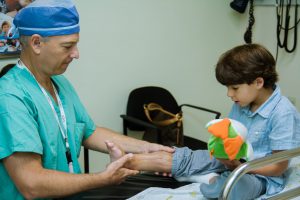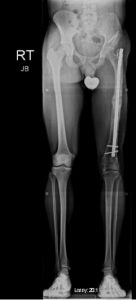Limb lengthening is a process that gradually grows new bone. Limb lengthening is used to correct limb length discrepancies and congenital short statures, and is often performed in conjunction with limb deformity correction. There are a number of birth defects that result in limb length discrepancies and congenitally short limbs. Skeletal abnormalities and dysplasias can also be corrected via lengthening, as well as achondroplasia and other dwarfisms. Patients suffering from post-traumatic injuries may also undergo lengthening as part of their treatment.
For inquiries on elective cosmetic stature lengthening, please see our Stature Lengthening Center.
How Does It Work?
 The limb lengthening process works by gradually growing new bone and soft tissues (skin, muscle, nerves, blood vessels, etc.). Bone and soft tissue regenerate when they are pulled apart at a very slow rate, a process known as distraction. The rate of distraction is typically one millimeter per day. Any faster and the bone may fail to form in the gap, muscles will become contracted, and nerves may become paralyzed; any slower and the bone will reform in the gap, a process known as premature consolidation, which halts the lengthening.
The limb lengthening process works by gradually growing new bone and soft tissues (skin, muscle, nerves, blood vessels, etc.). Bone and soft tissue regenerate when they are pulled apart at a very slow rate, a process known as distraction. The rate of distraction is typically one millimeter per day. Any faster and the bone may fail to form in the gap, muscles will become contracted, and nerves may become paralyzed; any slower and the bone will reform in the gap, a process known as premature consolidation, which halts the lengthening.
Lengthening is divided into two phases: distraction and consolidation. Lengthening happens during the distraction phase. After the desired length is obtained, the newly regenerated bone is still very weak. The hardening and calcification of this new bone is called the consolidation phase.
The Paley Approach
 Limb lengthening and limb deformity correction is a very complicated process. Meticulous surgical technique, vigilant follow up, and aggressive rehabilitation are required for a successful outcome. The results of lengthening are highly dependent on the experience of the surgeon and his surrounding clinical staff. Dr. Paley has been performing lengthening and limb deformity correction surgeries for over twenty-five years. He is currently the most experienced limb lengthening surgeon in the world, having performed over 17,000 lengthening surgeries.
Limb lengthening and limb deformity correction is a very complicated process. Meticulous surgical technique, vigilant follow up, and aggressive rehabilitation are required for a successful outcome. The results of lengthening are highly dependent on the experience of the surgeon and his surrounding clinical staff. Dr. Paley has been performing lengthening and limb deformity correction surgeries for over twenty-five years. He is currently the most experienced limb lengthening surgeon in the world, having performed over 17,000 lengthening surgeries.
The Alternative to Amputation
 Dr. Paley has developed over 100 new operative procedures for bone and soft-tissue reconstruction of congenital, developmental, and post-traumatic limb disorders. Dr. Paley has also reclassified many of the diagnoses he treats, shifting emphasis from amputation and prosthetic fitting to emphasizing reconstructive techniques. Dr. Paley’s approach to treatment goes in two directions: to develop (create/invent) and to improve both procedures and devices, in order to offer better treatment to his patients.
Dr. Paley has developed over 100 new operative procedures for bone and soft-tissue reconstruction of congenital, developmental, and post-traumatic limb disorders. Dr. Paley has also reclassified many of the diagnoses he treats, shifting emphasis from amputation and prosthetic fitting to emphasizing reconstructive techniques. Dr. Paley’s approach to treatment goes in two directions: to develop (create/invent) and to improve both procedures and devices, in order to offer better treatment to his patients.
Innovative Research
Dr. Paley has published over 100 articles in the peer-reviewed literature and has authored and edited five books and 45 book chapters. Dr. Paley has also been the principle investigator on several research grants. Dr. Paley is the author of Principles of Deformity Correction (Springer Verlag, 2002). This 800-page textbook is an orthopedic bestseller and has set the standard for the understanding and treatment of limb deformities. It teaches the analysis, planning, and methods of deformity correction and is supplemented by the exercise book, Principles of Deformity Correction Exercise Workbook (Springer Verlag, 2003), which was awarded best illustrated medical textbook in 2003.
Patient Cases
See the dramatic before and after photos in our Case Studies.
Patient Stories
Read our Patient Stories and see how limb lengthening at the Paley Orthopedic & Spine Institute changed their lives!
Conditions Treated
Dr. Paley has pioneered the treatment of many complex orthopedic conditions. His advances in the treatment of congenital deformities have given children who would have otherwise lost their legs, excellent function without the need for prosthesis. Dr. Paley has developed many specific surgical therapeutics for different uncommon and rare diseases in children and adults for both the upper and lower limbs. Some of his ground-breaking work has been in the treatment of:
- Congenital Femoral Deficiency
- Fibular Hemimelia
- Tibial Hemimelia
- Achondroplasia & Other Dysplasias
- Radial Club Hand & TAR Syndrome
- Congenital Pseudarthrosis of the Tibia
- Multiple Hereditary Exostoses
- Ptergyium Syndrome
- Melorheostosis
- Perthes Disease
- Madelung's Deformity
Electing a diagnosis will redirect to an in-depth explanation of the disorder and its treatment strategies. For a more extensive list of the diagnoses we treat, see Orthopedic Conditions
Treating Complications
There are many potential complications with lengthening surgery. Most complications are completely reversible by non-operative or operative means. It is critical to treat complications very aggressively in order to end up with normal function and no negative consequences from surgery.
This is why the results of lengthening are very dependent on the experience of the surgeon. A more experienced surgeon not only knows how to perform the surgery better, but knows how to prevent and treat complications so that there is no residual problem at the end of treatment.
Extramedullary Internal Limb Lengthening
a paper written by Claire Shannon, MD and Dror Paley, MD, FRCSC
Precice Max System
Learn about Precice Max Systems Weight-bearing Internal Lengthening Nail






